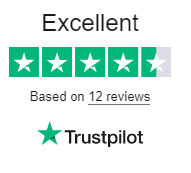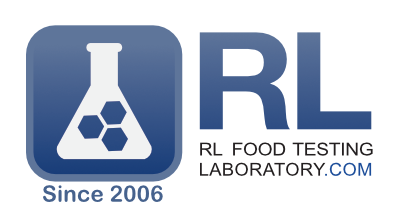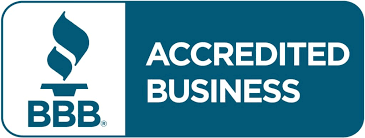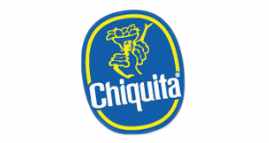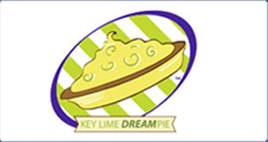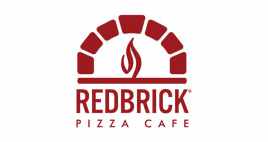FDA Food Nutrition Labels
FDA Compliant Food Labels & Allergen Statements
Fast. Accurate. FDA Compliant.
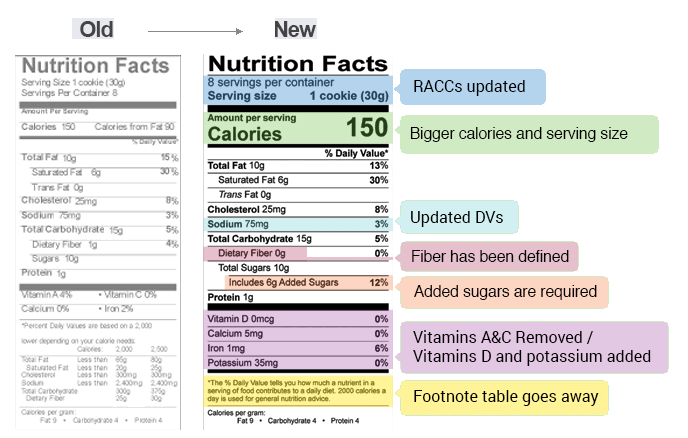

Get Started Now
Request a Recipe Template Learn More
Recipe Template Assistance


- Data Based Analysis
no samples or lab work needed in most cases - Ingredient Statement & Allergen Statement
most companies charge an additional fee for these required reports - Food Science and Registered Dieticians on Staff
We are here to help you on the journey to FDA compliance.
Trust an expert to make your FDA Compliant Nutrition Labels. We have the experience and training to do it right the first time.
Nutrition Fact Panel
$225.00
More Information about Food Nutrition Labels
What is a Nutrition Facts label?
A Nutrition Facts label, also known as a Nutrition Facts panel, is a small table placed on the packaging of most food and beverage products. It contains nutritional information about the product, such as amounts of Calories, fat, protein, carbohydrates, vitamins, and minerals. These amounts are provided on a per-serving basis.
Why is a Nutrition Facts label important?
An FDA nutrition label provides valuable information to your customers. In general, consumers are becoming increasingly aware of the relationship between their health and the food they eat. They often look for foods that are high in beneficial nutrients (such as protein, fiber, and vitamins or minerals) and that contain lower amounts of nutrients that they should limit (such as saturated fat, sodium, and cholesterol). In addition, some customers may follow diets that require them to control their intake of certain nutrients. FDA nutrition labeling can help consumers easily find and understand this information so that they can make informed decisions about the foods and beverages they buy.
There are also federal regulations from the FDA requiring you to provide Nutrition Facts panels on almost any food or drink that you sell. Failing to provide an accurate, compliant Nutrition Facts label could get your product removed from the market. For this reason, retailers will also want to make sure you have the necessary FDA labeling before they start selling your product.
What needs to be on a Nutrition Facts label?
The format and content of nutrition facts labeling is controlled by the FDA. In regard to content, you must provide the product’s serving size (i.e., the amount expected to be eaten in one sitting), as well as the number of servings per container. For each serving, the amount of each of the following must be listed as well:
- Calories
- Total fat
- Saturated fat
- Trans fat
- Cholesterol
- Sodium
- Total carbohydrate
- Dietary fiber
- Total sugars
- Added sugars
- Protein
- Vitamin D
- Calcium
- Iron
- Potassium
You will need to list these nutrient amounts in two ways: in an appropriate unit such as grams or milligrams, as well as in the percent of the recommended daily value (%DV) provided by one serving of the food. These recommended daily values come from the FDA’s general recommendations for the amount of each nutrient that a typical person should get from their diet; the percent daily value is the percent of the recommended amount that is present in one serving of your food or beverage. The exceptions to this are protein and trans fat, which do not have a daily recommended value, and therefore are only listed in grams. You must also include the definition of percent daily value at the bottom of your FDA Nutrition label.
Besides the nutrients which you are required to list on the nutrition label, as mentioned previously, there are certain other nutrients that you may list as well (such as soluble and insoluble fiber, different types of unsaturated fats, or some specific additional vitamins and minerals). In some cases, including these nutrients on your nutritional labeling is necessary, like when they are added to the food to supplement health, or when you make a claim or statement on your packaging about them (e.g., “this product is high in Vitamin C”). However, in other cases, you can include these additional nutrients in the Nutrition Facts panel voluntarily if you simply want to highlight them in this way. An example of an FDA nutrition label with some of these additional nutrients as shown below.
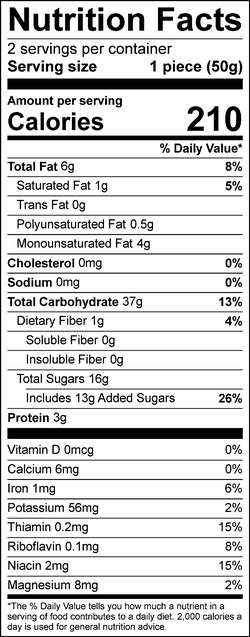

Dual Declaration Nutrition Label
In certain cases, you may also need to provide additional nutritional information in a special format called “dual declaration”. This is required if your container or package contains between two and three times the serving size of the food or beverage, or if your product consists of multiple separated pieces (such as multiple slices, muffins, pouches, etc.) and each piece contains two to three times the recommended serving size of the food. In the first scenario, your nutrition facts labeling will need to list the amount of each nutrient per package, in addition to the usual listing of their amount per serving. Similarly, in the second scenario, your nutrition facts labeling will need to list the amount of each nutrient per piece (slice, muffin, pouch, etc.), in addition to listing their amount per serving. These two types of dual declaration labels are shown below:
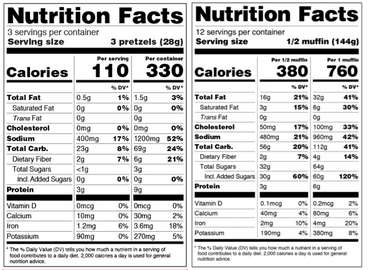

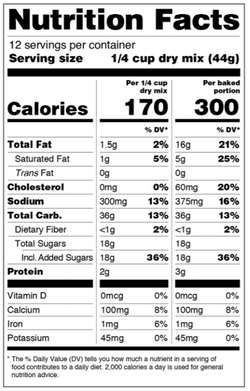

However, nutritional labeling is not as simple as just adding in the amounts of these nutrients. FDA labeling requirements also include very specific wording that must be used in certain sections of nutrition facts panels, such as when stating the serving size and the Daily Value definition. Additionally, regarding the amounts of the different nutrients, FDA labeling requirements have specific definitions for each nutrient (for example, the FDA has determined exactly which types of fibers can be included in the amount of “dietary fiber” listed on the label) and rules for how to round the numbers you list for the amount of each nutrient. There are also various formatting requirements – for instance, there are minimum font sizes and specific layouts in which the information must be arranged.
RL Foods: Your Partner In Nutrition Labeling Services
As you can see, creating a nutrition label for your food or beverage is very important to you and your customers, and doing it correctly involves a great deal of care and expertise. At RL Food Testing Laboratory, we will help you get a new nutrition label for your food or beverage product that is compliant with all FDA labeling requirements and that provides the information your customers are looking for. To get started, contact us using the form below or give us a call to speak to a representative.
What Are The New FDA Food Label Requirements?


Call Us
CALL US 7 DAYS A WEEK
877.753.6631
We are here to help


Fill Out Template
After we receive your payment, we will email you our recipe template for you to fill out with your recipe’s details.
Our nutrition labeling experts will be able to answer any questions you may have while filling out the template.
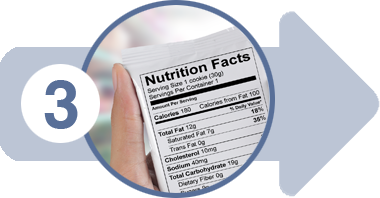

We Email Your Files
Your nutrition labels will be emailed to you in a PDF file that you can download and print or incorporate them into your food label.
*Vector file conversion available for a nominal fee.
CONTACT US 7 DAYS A WEEK
877.753.6631
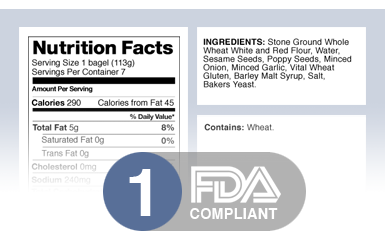

Complete Label Files
All (3) components required for FDA Compliant Nutrition Labels:
Nutrition Facts Panel
In all three formats: Standard, Tabular, and Linear
Ingredient statement
Allergen statement
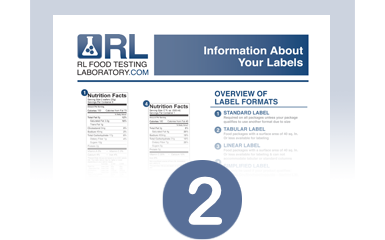

Food Labeling Guide
You’ll receive a copy of our Food Labeling Guide. This helpful guide shows you the proper format and placement to comply with FDA food labeling regulations.
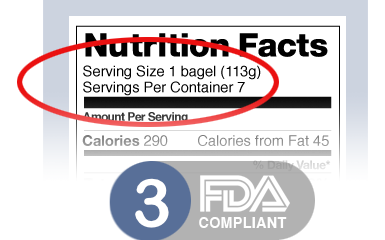

Servings Size Determination
We will help determine the Serving Size and Number of Servings per Container. Serving Size is specified in the FDA’s RACC (Recommended Amounts Customarily Consumed).
How do I know if I will need laboratory analysis to order a Nutrition label?
Because of their complex nature, these foods commonly require laboratory analysis:
- Fermented products, such as beer or wine
- Complex recipes that may be brined or marinated, such as a beef jerky
- Brewed products, such as coffee or tea
Please contact us to discuss your food product. We can determine if your product will need laboratory testing.
Does the price for Nutrition Labels involve lab testing?
No. This service is for nutrition labels made using data-based analysis– no food samples will need to be sent to a lab for this service. Most food recipes can be analyzed through our data-based software. Data-based software analysis costs much less and is less time consuming compared to lab analysis; however, lab testing is necessary in some cases (for more information, see “How do I know if I will need laboratory analysis to order a Nutrition label?”).
Why do I need to provide nutrition information for processed foods used in my recipe?
For all processed foods used in your recipe, you will need to provide a copy of the nutrition facts label, ingredient statement, and allergen statement. This will ensure that your analysis is accurate and that the final nutritional information reflects the nutritional value imparted by each of your particular ingredients, since we will load the specific nutritional information from the your recipe’s processed foods into our nutritional analysis software. In addition, FDA labeling requirements mandate that we list your final ingredient statement in descending order by percent weight; this is only possible if we have access to the ingredient statement of each of your individual ingredients.
Please note that “processed foods” includes almost every food apart from raw produce, pure meat, water, and some pure ingredients such as salt, pure oils, etc. When submitting your recipe, please check the labels of every ingredient you use. Even some foods that might not be considered “processed” may have additional ingredients that will need to be listed in your final label (e.g., sliced apples, which may have added contain ascorbic acid). Additionally, many ingredients that are often considered basic or pure may actually have sub-ingredients. Some examples include brown sugar (ingredients: sugar and molasses), all-purpose flour (which contains several added vitamins and minerals), or vinegar (ingredients: vinegar, water).
If my food product can be analyzed through the database software, what information do I need to give you to order a Nutrition Facts Label?
You will need to provide us with:
- Your recipe, including a complete list of ingredients and sub-ingredients with the amount of each ingredient and sub-ingredient in grams, ounces, percentages, or Household Measurements (for example, ½ cup white sugar, 60g water, etc.)
- A copy of the Nutrition Facts Label, Ingredient Statement, and Allergen Statement of any processed food ingredient (for example, enriched flours, canned tomatoes, etc.)
- The number of servings per recipe, the Serving Size in grams or ounces (for food) or milliliters (for beverages and liquids), and the number of Servings per Container (don’t worry – if you don’t know what these amounts should be, we can help you determine the correct amounts)
- For cooked or baked foods: the percent moisture lost during cooking, or the weight of your product before and after cooking (for more details, refer to “How do I determine the percent of moisture in my finished product lost during cooking or baking?”)
How do I determine the percent moisture lost during cooking or baking?
To determine the percent moisture lost, begin by performing the following steps:
- First, weigh your product before cooking and record this weight.
- After cooking, weigh the product again. Record this weight as well.
- Lastly, subtract the weight of the cooked product (from step 2) from the weight of the product before cooking (from step 1). This will give you the amount of moisture lost during cooking.
For example, if you have 18g of dough before baking and the final weight of the product after baking is 13g, your moisture loss is18g-13g=5g.
To convert the amount of moisture lost to the percent of moisture lost, divide the weight of moisture lost (from step 3 above) by the original weight of the product before cooking (from step 1 above).
For example, 5g moisture lost/18g dough=28% moisture loss.
Why do I need to know the moisture loss, or the weight of my food product before and after cooking?
The amount of moisture that is lost will affect the nutritional values retained in your final product. The weight of your food product before and after cooking can be used to determine the moisture loss.
How do I weigh my food product or ingredients?
You will need to use a scale that provides weight in grams or ounces.
To find the weight of a product that must be weighed in a container (for example, salad dressing), you will need to perform the following steps:
- First, you will need to weigh the empty container that you will be using and record that weight.
- Next, add your product to the container, and record the total weight of the container with your product inside.
- Then, subtract the weight of the empty container (from step 1) from the weight of the container with the product inside (from step 2). This will give you the weight of the product itself, without the container.
For example: If the weight of the bowl or container in which you weight your food is 0.5 ounces, and the total weight of your food product plus the container is 4 oz., then the weight of your product itself will be 4 oz-0.5 oz=3.5 oz
How do I determine the number of Servings per Container?
To determine the number of Servings per Container, divide the total Net Weight of your product by the weight of one Serving Size. For example:
Net Weight: 16oz (454g)
Serving Size: 2 Tbsp (33g)
454g / 33g = 13.75 servings
Round 13.75 up to 14
Servings: about 14
Please note: there are rounding rules established by the FDA. We will help determine the correct number of Servings per Container for your label.
What is a Serving Size and how do I determine the Serving Size for my recipe?
The Serving Size is the amount of a food or beverage that one would typically consume in one sitting. The Serving Size is displayed as two parts: a “household measure term” followed by its metric equivalent. For example, an appropriate serving Serving Size could be “2 Tbsp (33g)”, where 2 Tbsp is the household measure and 33g is its metric equivalent.
To find the suggested Serving Size for a particular product, use the FDA’s Reference Amounts Customarily Consumed (RACC) guidelines.
We will help you determine the correct Serving Size for your food or beverage product per the FDA’s RACC.
What is listed in the Ingredient Statement?
All the ingredients in your recipe must be shown, including all sub-ingredients (i.e., the ingredients that make up your ingredients).
The ingredients must be listed in descending order by percent weight. The percent weight of an ingredient is calculated by dividing the weight of an ingredient used in the recipe by the total weight of the recipe.
What allergens, if present, need to be listed in the allergen statement on my label?
There are eight allergens that, if present in the food, must be listed in the allergen statement:
- Eggs
- Fish
- Milk
- Peanuts
- Shellfish
- Soy
- Tree Nuts
- Wheat
If your product (or its ingredients) contain any of the above allergenic foods, or contain ingredients derived from those foods, then the corresponding allergen must be listed in the allergen statement.
What do I do with my food’s Nutrition Facts Label files once I receive them?
You have a few options: you can either print the labels and place them on your package, or your graphic artist can incorporate them into your food label or packaging. Please keep in mind that there are specific guidelines from the FDA on size and placement of the Nutrition Facts panel.
With your order, you’ll receive our Food Labeling Guide, which covers the FDA regulations you will need to know for proper placement and sizing.
Can I put my nutrition label anywhere on my food’s packaging?
No. The nutrition facts panel, ingredient statement, and allergen statement should go in the “information panel” of the label as mandated by the FDA.
Another important FDA regulation on food labeling pertains to the Nutrition Facts panel formatting. The Nutrition Facts panel is available in different formats, and the format that you use depends on how much space is available on your food’s packaging.
When you order, you will receive a free copy of our Food Labeling Guide, which explains proper placement of the nutrition facts label.
Chocolate Manufacturers: Testing and Labeling Essentials
A How to Guide for Meal Prep Product Labeling
Understanding Testing Needs for Frozen Yogurt
(FDA) Requirements For Food Labeling
What Are the Current FDA Labeling Requirements and What Happens If I Am Not Compliant?
Do I Need to Make an FDA Nutrition Label for my New Food or Drink?
When to Get an FDA Nutrition Label and Why
Infographic of Key Changes to the Nutrition Facts Label
Your recipes are safe with us!
All clients receive a declaration of confidentiality in our Statement of Work.


Work Accuracy Guarantee
100% accurate and FDA compliant or your money back.*


Conditions
We have helped
thousands of happy clients since
2005


7 Days a Week!
Available 7 days-a-week to answer your questions


A+ rating with BBB
Accredited member since 2014
